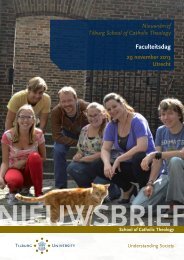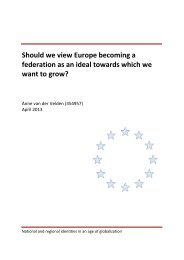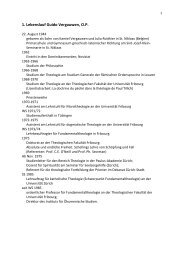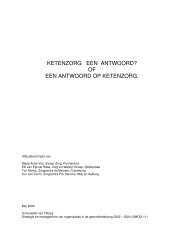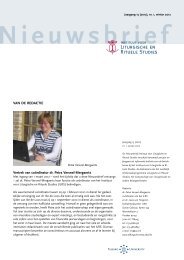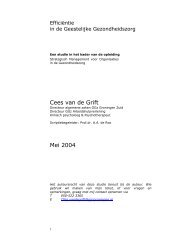Here - Tilburg University
Here - Tilburg University
Here - Tilburg University
Create successful ePaper yourself
Turn your PDF publications into a flip-book with our unique Google optimized e-Paper software.
Author and presenter<br />
Barban, Nicola; Dondena Centre, Università Bocconi; Centre for Population<br />
Studies, Ageing and Living Conditions programme, Umea <strong>University</strong><br />
Title<br />
Sequence analysis and causality. The effect of age at retirement on health using<br />
Swedish register data<br />
Abstract<br />
Life expectancy is increasing steadily in developed countries. Governments<br />
are seeking to increase the proportion of elderly people in paid employment to<br />
balance the ratio of employed people over dependent ones. This led to a<br />
considerable debate about the timing of retirement and its influence on health:<br />
is early retirement good or bad for your health? Several studies have shown that<br />
retirement at younger age has adverse effects on health (e.g., Westerlund and<br />
al. 2010, Hult and al., 2010). However, selection into retirement may obscure<br />
the effect of retirement on health. The individual decision to retire can be<br />
influenced by previous health trajectory, marital status and widowhood, social<br />
relations with relatives and work career. Moreover, the transition to retirement<br />
has become blurred, and the actual range of retirement age has expanded,<br />
making the transition “longer and fuzzier” (Kohli and Rein 1991; Han and<br />
Moen,1999). As a result, retirement is becoming more “destandardized” and<br />
“deinstitutionalized” (Guillemard and Rein 1993, Guillemard and van Gunsteren<br />
1991) with people anticipating retirement entering periods of inactivity or<br />
reducing their labor supply. Starting from this theoretical framework, we develop<br />
a new matching approach to investigate the causal effect of age at retirement on<br />
later health outcomes. Standard matching estimators (Rosembaum and Rubin<br />
1985) based on propensity score pair each treatment participant with a single<br />
(or multiple) non-treated participant based on a set of observed characteristics.<br />
However, we claim that selection into treatment can be affected by the<br />
trajectories of a set of observed characteristics before treatment. For this<br />
reason, using sequence analysis with Optimal Matching (OM) (Abbott, 1995), we<br />
develop a matching procedure based on the trajectory before treatment. Our<br />
method use an extension of nearest neighborhood matching estimator using OM<br />
distances. In this way we matched individuals with the most similar trajectory




